A military prison that held Slovenes and others during Yugoslavia’s development and downfall has been transformed into a veritable work of art. 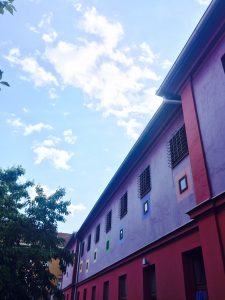 It is now a youth hostel where each space serves a purpose, whether for function, aesthetic appeal, or historical evidence. This unconventional buildingnot only functions as a youth hostel, but also as a museum, art gallery, concert hall, and café. Our tour guide (and accomplished architect) Janko Rožic thoroughly described the significance of objects from the front door (which represents a map of the building’s footprint) to the courtyard where the prisoners walked and even the hostel bedrooms which possess their own unique style, each designed by different artists. Janko was key among the artists who transformed the prison into what it is today, located in the alternative culture Metelkova area of Ljubljana.
It is now a youth hostel where each space serves a purpose, whether for function, aesthetic appeal, or historical evidence. This unconventional buildingnot only functions as a youth hostel, but also as a museum, art gallery, concert hall, and café. Our tour guide (and accomplished architect) Janko Rožic thoroughly described the significance of objects from the front door (which represents a map of the building’s footprint) to the courtyard where the prisoners walked and even the hostel bedrooms which possess their own unique style, each designed by different artists. Janko was key among the artists who transformed the prison into what it is today, located in the alternative culture Metelkova area of Ljubljana.

As a sustainability minor, I was intrigued by the building’s embrace of sustainable design and eco-efficiency. Materials which would have normally been discarded as waste have been given new lease on life. One example is the reclaimed wood that serves as bedroom furniture. Sustainability can even be seen in the art gallery. Tea and fruit juice, two ingredients directly derived from nature, were utilized, resulting in a variety of beautiful works of art.
The design also illustrates the building’s history. 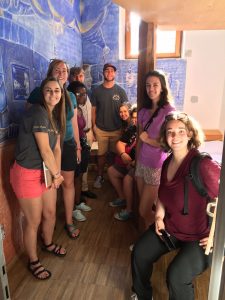 The floor in the main hallway, located on the second level, was designed to be high towards doors on each side and dip down in the center. When exiting a room, a gravitational boost results, creating a light feeling and sense of relief. This represents how the prisoners felt when they left their tiny cells and, ultimately, when they were released from confinement: lighter.
The floor in the main hallway, located on the second level, was designed to be high towards doors on each side and dip down in the center. When exiting a room, a gravitational boost results, creating a light feeling and sense of relief. This represents how the prisoners felt when they left their tiny cells and, ultimately, when they were released from confinement: lighter.
Even though the prison represented a dark time in Slovenian history–it was also used as a prison by Italian Fascists and then the German Nazis in WWII–its transformation did not sweep the gloom under the rug. Instead, a few reminders, such as barbed wire and barred windows were left intact. This experience emphasized how combining art, intelligent design, and history can create a successful business which positively impacts the lives of others and reflects God’s goodness.
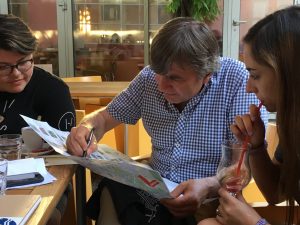
It inspires me to not negatively view tragedies of the past, but instead, transform negative events into something positive. This optimistic view can be applied to any adversity one faces. This expresses Mind, and how we reflect God’s inexhaustible intelligence which we can use to transform adversity into inspiration.
The group thanks Janko for opening our eyes to so many new perspectives.
~Jolee
Jolee Keplinger, a sophomore, is majoring in mass communication with a minor in sustainability. Her hobbies include blogging, cooking, and anything involving art. She’s known as a foodie so it’s no surprise that her cultural presentation topic is Slovene cuisine.


 made our 20-minute walk to school. The city was busy with drivers, bicyclists, and pedestrians, but there was a calm to the movement. Everyone knew where to go and how to get there. There did not seem to be any unnecessary chitchat, and most people kept to themselves. As we neared the building, it was clear our group was eager to learn more about the unique language of Slovenian. We were greeted by our wonderful teachers, Anja and Nina, and the lesson soon began.
made our 20-minute walk to school. The city was busy with drivers, bicyclists, and pedestrians, but there was a calm to the movement. Everyone knew where to go and how to get there. There did not seem to be any unnecessary chitchat, and most people kept to themselves. As we neared the building, it was clear our group was eager to learn more about the unique language of Slovenian. We were greeted by our wonderful teachers, Anja and Nina, and the lesson soon began.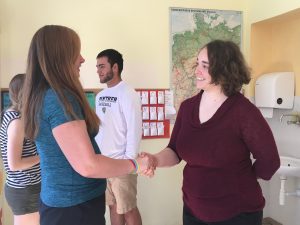 We went through several activities, and when the 90 minutes were up, we were all surprised at how quickly it flew by. Even moreso, we all were anxiously awaiting the day to follow in which we could practice our new vocabulary.
We went through several activities, and when the 90 minutes were up, we were all surprised at how quickly it flew by. Even moreso, we all were anxiously awaiting the day to follow in which we could practice our new vocabulary.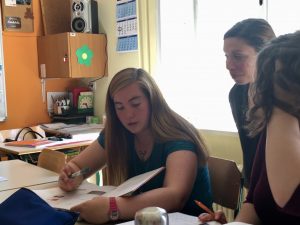 pairs for lunch, the group decided to stick together and go to the highly recommended Cantina Mexicana. Some brave souls chose to order their meals in broken Slovene, and the waiter patiently listened and carefully watched where we pointed on the menu.
pairs for lunch, the group decided to stick together and go to the highly recommended Cantina Mexicana. Some brave souls chose to order their meals in broken Slovene, and the waiter patiently listened and carefully watched where we pointed on the menu.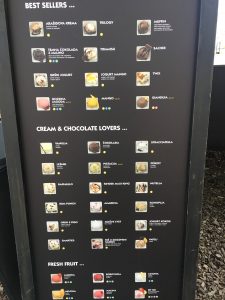 and were ready for a nap. Some plates looked as if the food had not even been touched as to-go boxes were delivered to our tables. It has become very clear to each of us that Slovenians make sure you have had enough to eat and do not allow a plate to leave the kitchen if not every inch has at least a morsel of food.
and were ready for a nap. Some plates looked as if the food had not even been touched as to-go boxes were delivered to our tables. It has become very clear to each of us that Slovenians make sure you have had enough to eat and do not allow a plate to leave the kitchen if not every inch has at least a morsel of food.